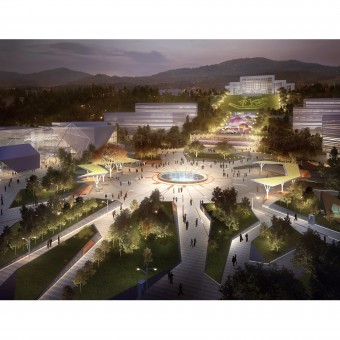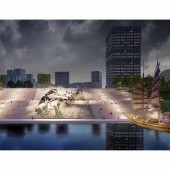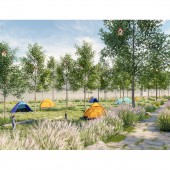Wanzhou Riverside Landscape Corridor Commercial by Yiping Yu and Huadong Zhang |
Home > |
 |
|
||||
| DESIGN DETAILS | |||||
| DESIGN NAME: Wanzhou Riverside Landscape Corridor PRIMARY FUNCTION: Commercial INSPIRATION: The Binjiang Road in Wanzhou District has witnessed the historical change of the city. Wanzhou District is named after a saying goes as "ten thousand rivers form a lake, where Wanzhou is established". The "Gaoxiapinghu&q UNIQUE PROPERTIES / PROJECT DESCRIPTION: This project is planned to conduct strategic reconstruction and building of riverside space along the Gaoxiapinghu, with the aim to create ecological waterfront areas and a dynamic riverside corridor, improve the urban quality, and increase development efficiency of the urban function. OPERATION / FLOW / INTERACTION: Taking the large stairway as an example, based on the original large-scale downriver steps and platforms, the characteristics of vertical height difference of the "Mountain and River City" will be highlighted by adding the cultural theme of "Wharf and Boat Trackers at Three Gorges", and a three-dimensional picture of steps will be constructed, creating two different experience and interactive effects. In this way, people walking on the steps and tourists on the river will have two very different experiences. At the same time, the beaches resources in the water-level-fluctuat PROJECT DURATION AND LOCATION: The project started in June 2018 and finished in February 2019 in Wanzhou District, Chongqing. It covers an area of some 352.7 hectares. |
PRODUCTION / REALIZATION TECHNOLOGY: 1. Exploration of culture: The landscape construction of the project relies on four core cultures explored and selected from various cultural elements of Wanzhou, including the Three Gorges Culture, Port-opening Culture, Poem Culture, and Red Culture. 2. Demands: The citizens' demand for leisure life and the tourists' demand for sightseeing are taken into consideration to improve functions and facility services, and shape different landscapes including the Creative Market, Theater and Public Science & Technology Recreation Area on the north bank, and the Projection Corridor, Rainbow Bridge and Romance Experience Area on the south bank. As a result, the interaction and experience will be enhanced, and vitality of places stimulated. 3. Ecological restoration: The sponge city method is adopted to carry out the regeneration design of Hongxigou wetland, achieving the regulation and storage of rainfall and flood plus the water recycling; the ancient culture is incorporated into landscapes in the Hongshaqi Park based on the water ecology. 4. Co-existence with water: Almost all landscapes are built along the river to enhance the co-existence of landscapes and the river. The construction of waterfront interaction designs like waterfront plank road and waterscapes like fountains and water curtains, as well as the development of water entertainment projects, not only deepens the utilization of water but also strengthens a sense of entertainment and experience. 5. Riverside landscape: To solve problems including over-engineering of the hydro-fluctuation belt and single-color plants and spacial occlusion in riverside parks, the landscaping method is adopted to create a three-dimensional space featuring seasonal plants, different understory plants, and open places. SPECIFICATIONS / TECHNICAL PROPERTIES: Our design is to plant trees at the places where the water level is below 175.00. Meanwhile, we put forward special requirements on the structural design of framed flower bed, and the integrated concrete pouring method will be specially used to ensure the structural stability of framed flower bed and the survival rate of trees under water immersion for nearly half a year and under locally water impact. As for the selection of seedlings, Taxodium zhongshansha, Mollugo stricta L., etc. were selected through field tests. TAGS: Ecological restoration, Cultural renaissance RESEARCH ABSTRACT: Research type: Study on the Utilization of Waterfront Space of Mountainous City Research Target: Design Model of Waterfront Space of Mountainous City Methodologies: background research, demand analysis, problem posing, problem analysis, problem solving, target building, and implementation design Data collection: questionnaire, current strategies, analysis and statistics The Project will promote the improvement of Wanzhou city quality and the development of urban tourism. It will benefit the people's livelihood, meet the market demand, and shape the city image. It can drive the economic development of Wanzhou District and enhance the city image. CHALLENGE: The change of water level in the Three Gorges reservoir area has brought great challenges to the design. In order to achieve the goal of "returning the river to the people and going back to the waterfront", the ways of sightseeing experience for different groups of people are put forward in the design according to different elevations and seasons, such as the slow viewing corridor of sidewalk, platform at 173.00 water level and above, and grass planting grid below 173.00. This Project will build a green belt between the river and the city, and create the biodiversity habitat by reshaping the waterfront living space, creating various waterfront landscapes and strengthening the accessibility of the riverside area and the connection with the city. ADDED DATE: 2020-09-05 09:44:17 TEAM MEMBERS (15) : Senior Engineer: Yiping Yu, Senior Engineer: Huadong Zhang , Senior Engineer: Mingming Li , Senior Engineer: Haijiang Fan , Senior Engineer: Xin Liu , Engineer: Ying Liu , Engineer: Xiaolei Wei, Planner: Tongxi Liu , Engineer: Yuhan Liu , Engineer: Tianbao Liu , Engineer: Qing Liao , Engineer: Peng Wang, Senior Engineer: Ye Kuang , Engineer: Yue Xiao and Planner: Juanli Yu IMAGE CREDITS: Yiping Yu and Huadong Zhang , 2020. |
||||
| Visit the following page to learn more: http://www.cqhaofeng.com/ | |||||
| AWARD DETAILS | |
 |
Wanzhou Riverside Landscape Corridor Commercial by Yiping Yu and Huadong Zhang is Runner-up for A' Design Award in Landscape Planning and Garden Design Category, 2020 - 2021.· Read the interview with designer Yiping Yu and Huadong Zhang for design Wanzhou Riverside Landscape Corridor here.· Press Members: Login or Register to request an exclusive interview with Yiping Yu and Huadong Zhang . · Click here to register inorder to view the profile and other works by Yiping Yu and Huadong Zhang . |
| SOCIAL |
| + Add to Likes / Favorites | Send to My Email | Comment | Testimonials |








